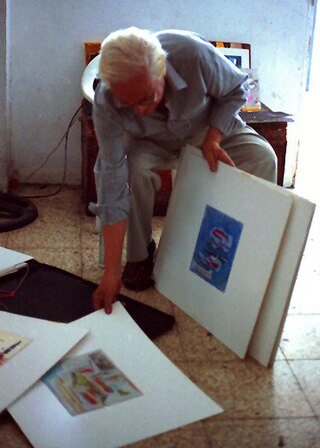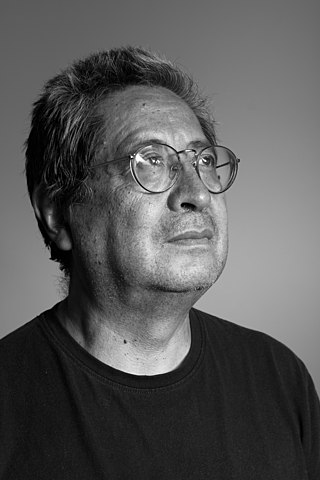Related Research Articles
The music of Ecuador is a diverse aspect of Ecuadorian culture. Ecuadorian music ranges from indigenous styles such as pasillo to Afro-Ecuadorian styles like bomba to modern indie rock like "Cambio de Tonalidad" by Da Pawn.
José María Egas was an Ecuadorian poet. Many of his poems were turned into the lyrics of "pasillos". Egas studied law at the University of Guayaquil graduated in 1927. He was then active as a lawyer and journalist, but became best ko

Jorge Enrique Adoum was an Ecuadorian writer, poet, politician, and diplomat. He was one of the major exponents of Latin American poetry. His work received such prestigious awards as the first Casa de las Américas Prize in Cuba, the most important honor in Latin American letters. Though hailed by Nobel Prize winner Pablo Neruda as the best poet of his generation in Latin America, Adoum’s work is unknown in the English-speaking world.

Alfredo Pareja Diezcanseco — born Alfredo Pareja y Díez Canseco — was a prominent Ecuadorian novelist, essayist, journalist, historian and diplomat. An innovator of the 20th-century Latin American novel, he was a founding member of the literary Grupo de Guayaquil, which brought a new emphasis to realistic novels.

Julio Alfredo Jaramillo Laurido was a notable Ecuadorian singer and recording artist who performed throughout Latin America, achieving great fame for his renditions of boleros, valses, pasillos, tangos, and rancheras.

Luis Enrique Tábara was a master Ecuadorian painter and teacher representing a whole Hispanic pictorial and artistic culture.
Jorge Saade is a violinist.

Mesías Maiguashca is an Ecuadorian composer and an advocate of Neue Musik, especially electroacoustic music.
Pasillo is a Colombian genre of music popular in the territories that composed the 19th century Viceroyalty of New Granada: Born in the Colombian Andes during the independence wars, it spread to other areas; especially Ecuador and, to a lesser extent, the mountainous regions of Venezuela and Panama. Venezuelans refer to this style of music as "vals". Today, it has incorporated more European features of classical dance, such as Viennese waltz in Colombia and features of sanjuanito and yaraví in Ecuador. As it spread during the Gran Colombia period, pasillo also absorbed the individual characteristics of isolated villages. This gives it an eclectic feel; however, the style, tone, and tempo of the music differ in each village and indeed between each country.

Juan Fernando Velasco is an Ecuadorian musician.
Carlos Galo Raúl Bonilla Chávez, better known as Carlos Bonilla was one of the pioneers of the Ecuadorian classical guitar and an important figure in 20th-century Ecuadorian music.

Enrique Gil Gilbert was an Ecuadorian novelist, journalist, poet, and a high-ranking member of the Communist Party of Ecuador.
Arturo Rodas is an Ecuadorian-born French-citizen composer.
Luis Humberto Salgado was an Ecuadorian composer. He was regarded as one of the most influential and prolific composers of his country.

Instituto Nacional Mejía is a public secondary educational institution of Quito. It was founded on June 1, 1897 by Eloy Alfaro Delgado, then president of Ecuador.
Jacobo Ficher was a Russian-born Argentine composer, violinist, conductor, and music educator.

Rafael Díaz Ycaza was an Ecuadorian poet, novelist, short story writer, and columnist for the Ecuadorian newspaper El Universo.

Carlos Aurelio Rubira Infante was an Ecuadorian singer and songwriter of pasillo and pasacalle music.

María Isabel Carlota Jaramillo, stage name Carlota Jaramillo was an Ecuadorian pasillo singer, known as "La Reina de la Canción Nacional".
Ángel Leónidas Araújo Chiriboga (1900-1993) was an Ecuadorian composer, poet, tax collector and hotelier, best known for his contributions to the pasillo genre.
References
- ↑ Anonymous, Jay (2017-06-26), "My name is Jay, I transitioned and I'm a disabled young athlete", Transgender Athletes in Competitive Sport, Routledge, pp. 23–31, doi:10.4324/9781315304274-3, ISBN 9781315304274 , retrieved 2021-09-06
- ↑ Pérez Pimentel
- ↑ Stevenson, 2001. 20:685
- ↑ Behague, 2001. 7:872